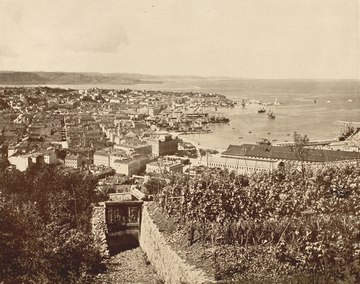The Italians in the Litoral (German: ‘Küstenland’, made up of the county of Görz, Trieste and Istria) were likewise torn between their traditional loyalty to the Habsburg Monarchy and the appeal of Italian irredentism. In view of the growth of the southern Slav nationalist movements in the eastern Adriatic region, they also feared for their privileged position as the dominant ethnic group. Trieste in particular was the scene of severe ethnic conflict.
Even under Austrian governance, there was never any questioning of Italian as the language of education and administration in the northern Italian provinces. Of all the many languages of the Habsburg Monarchy, Italian was the only one that constantly enjoyed the same high standing as German.
After the loss of Lombardy and Venetia, Austria’s only remaining provinces with a majority of Italian-speakers were the Litoral with Trieste, and the Trentino. While the ethnic borders were relatively clear in the Tyrol, there was a more complicated situation in the Litoral, where Italian no longer enjoyed undisputed primacy and faced serious challenges from Slovene and Croatian. While the towns were generally Italian-dominated, the rural hinterland was home to Slovene- or Croatian-speakers, which generated an enormous potential for conflict with the up-and-coming southern Slav nationalist movements.
In the late nineteenth century Trieste (Slovene/Croatian: Trst) was the scene of particularly bitter struggles over national rights of possession. After having been made a free city in 1719, it developed into the Monarchy’s most important port and was a magnet for migrants from the entire eastern Adriatic region. Although the Italian middle classes traditionally enjoyed a position of dominance in Trieste, they were confronted with a southern Slav population that was growing in numbers on account of large-scale Slovene and Croat immigration from the hinterland.
Around 1900, 77.4 per cent of Trieste’s 160,000 inhabitants registered Italian as their everyday language, 16.3 per cent Slovene (or ‘southern Slav’, as at that time no distinction was made between Slovenes, Croats and Serbs), and 5.9 per cent German. By 1910, 25.9 per cent of Triestines were southern Slavs, which meant that Trieste had more Slovene-speakers even than Laibach (Slovene: Ljubljana), which was the capital of the Slovenes’ core homeland, the Austrian dukedom of Carniola.
The virulence of nationalist agitation on both sides poisoned relations between the Italians and the Slovenes, who demanded equality of status for their language in education and administration. To complicate matters, not only were the Italian Triestines on the defensive against the southern Slavs but they had also developed strong separatist tendencies, with their historic loyalty to the Habsburg Monarchy being eroded by their desire for unification with the Italian nation-state.
As so often, the conflict was at its most explosive in the field of education. Although the Italian primary and secondary schools of the Habsburg Monarchy were well organized, there were shortcomings in further education, as the loss of Lombardy and Venetia meant that Austria no longer possessed an Italian university. As a result, the legitimate demand for a university in Trieste became a political issue, because it was seen as a means of countering Slovene demands in the city. In 1913, after long discussions, the foundation of a university was agreed to, but it was never realized on account of the outbreak of war.
Translation: Peter John Nicholson
Corsini, Umberto: Die Italiener, in: Wandruszka, Adam/Urbanitsch, Peter (Hrsg.): Die Habsburgermonarchie 1848–1918, Band III: Die Völker des Reiches, Wien 1980, Teilband 2, 839–879
Rumpler, Helmut: Eine Chance für Mitteleuropa. Bürgerliche Emanzipation und Staatsverfall in der Habsburgermonarchie [Österreichische Geschichte 1804–1914, hrsg. von Herwig Wolfram], Wien 2005
Štih, Peter/Simoniti, Vasko/Vodopivec, Peter: Slowenische Geschichte. Gesellschaft – Politik – Kultur, Graz 2008




